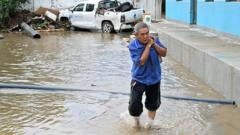The floods have already claimed a total of 44 lives across Beijing and surrounding areas, taking place during an exceptionally severe summer weather season throughout China. The incident has sparked discussions regarding gaps in emergency response protocols and the need for improved measures to protect vulnerable populations.
In Taishitun Town, where the nursing home is situated, around 77 residents were present at the time of the flooding. Due to the circumstances, approximately 40 individuals could not be evacuated as rising water levels reached nearly 2 meters (6 feet). The facility primarily supports residents who are severely disabled and low-income, indicating a critical need for enhanced safety protocols in disaster situations.
Officials have acknowledged deficiencies in their emergency planning, revealing that the location had been deemed safe for years and thus omitted from precautionary evacuation measures. "This event has shown that our understanding of extreme weather patterns is lacking, emphasizing the need for reform in our emergency strategies," stated a government representative during a press conference.
Nearby Hebei province also reported 16 fatalities from the extreme rainfall, with additional casualties in cities like Chengde. Beijing, prone to seasonal flooding, faced one of its deadliest storms in 2012, prompting heightened awareness around disaster management.
Recent flooding across various regions of China has strained resources and destabilized communities. The prevalence of extreme weather events, linked to climate change, puts additional pressure on China's agricultural economy, which has already incurred substantial financial losses due to natural disasters this year.
This tragic event emphasizes the urgent need for comprehensive emergency preparedness and response strategies, particularly for vulnerable populations in high-risk areas.
As climate patterns shift and severe weather events become commonplace, it’s essential that systems in place evolve to safeguard lives in the face of natural disasters.
In Taishitun Town, where the nursing home is situated, around 77 residents were present at the time of the flooding. Due to the circumstances, approximately 40 individuals could not be evacuated as rising water levels reached nearly 2 meters (6 feet). The facility primarily supports residents who are severely disabled and low-income, indicating a critical need for enhanced safety protocols in disaster situations.
Officials have acknowledged deficiencies in their emergency planning, revealing that the location had been deemed safe for years and thus omitted from precautionary evacuation measures. "This event has shown that our understanding of extreme weather patterns is lacking, emphasizing the need for reform in our emergency strategies," stated a government representative during a press conference.
Nearby Hebei province also reported 16 fatalities from the extreme rainfall, with additional casualties in cities like Chengde. Beijing, prone to seasonal flooding, faced one of its deadliest storms in 2012, prompting heightened awareness around disaster management.
Recent flooding across various regions of China has strained resources and destabilized communities. The prevalence of extreme weather events, linked to climate change, puts additional pressure on China's agricultural economy, which has already incurred substantial financial losses due to natural disasters this year.
This tragic event emphasizes the urgent need for comprehensive emergency preparedness and response strategies, particularly for vulnerable populations in high-risk areas.
As climate patterns shift and severe weather events become commonplace, it’s essential that systems in place evolve to safeguard lives in the face of natural disasters.





















